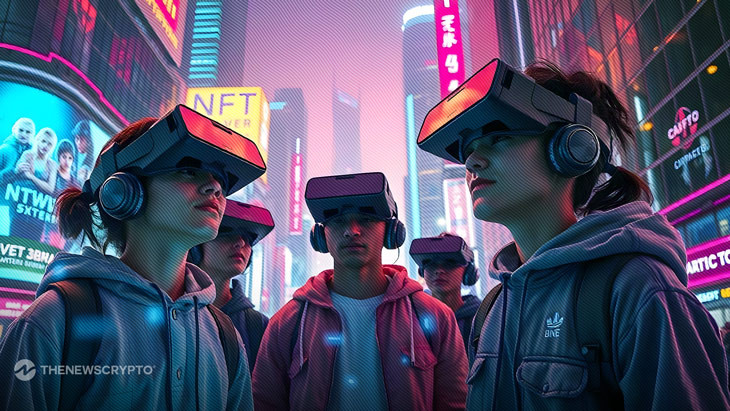The NFT market has developed remarkably since its speculative beginnings and has become an integral part of the digital economy by 2025. In addition to art, NFTs now include gaming, virtual real estate, fashion and tokenization of real-world assets, reshaping industries and redefining ownership in the digital age.
NFT Market Insights for 2024
The NFT ecosystem in 2024 showed both growth and refinement. Trading volumes exceeded $2 billion, demonstrating continued interest despite a challenging macroeconomic landscape. In November, monthly trading volume rose to $698 million – a 22% increase from October. However, the number of sales fell by 11% to 3 million transactions, indicating a shift towards fewer higher value transactions. Collections from Yuga Labs and other iconic makers dominated, highlighting NFTs not only as cultural phenomena but also as investment vehicles.
Moreover, corporate participation in NFTs also gained momentum. McDonald’s partnership with Doodles for the “GM Spread Joy” campaign brought NFTs to a global audience, combining branding with digital innovation. However, recalibration was evident as some companies streamlined their NFT efforts. Nike’s decision to close RTFKT by January 2025 underlines the shift toward more targeted and strategic investments in the space.
From a technical perspective it is Ethereum remained the leader in trading volume, driven by its dominance in high-end collections. Polygon, on the other hand, emerged as the leader in transaction numbers, supported by its integration with Instagram for direct NFT sales. Gaming, powered largely by Polygon and Immutable, was a major contributor to NFT activity, demonstrating the growing relevance of NFTs in interactive digital experiences.
Trends Shaping NFTs in 2025
As the NFT market matures, several trends are shaping its trajectory, reflecting a move toward utility, sustainability, and cross-platform integration.
1. NFT interoperability
The future of NFTs lies in their ability to work seamlessly across multiple networks blockchains. Projects like Polkadot and Cosmos are driving this transformation by creating infrastructure that allows NFTs to be used and traded across ecosystems. This interoperability not only improves the user experience, but also drives innovation, allowing digital assets to exist within a unified, connected digital universe.
2. NFTs in the Metaverse
In the metaverse, NFTs are revolutionizing the concept of ownership. Virtual real estate, avatars and digital goods are now tokenized, allowing users to buy, sell and trade them with transparency and security. Platforms such as The Sandbox And Decentraland keep leading this space. According to DappRadar, the virtual real estate market is expected to grow 50% annually as the metaverse becomes more interactive and immersive, making NFTs an integral part of digital life.
3. Gaming NFTs
The gaming industry has embraced NFTs beyond the original play-to-earn model. Titles like Illuvium pioneering a new era where NFTs take center stage in gameplay mechanics, increasing player engagement and offering true ownership of in-game assets. This shift signals a move toward integrating blockchain technology into core game design, giving players deeper, more immersive experiences.
4. Sustainable NFTs
As concerns about environmental impacts grow, the NFT market is responding with greener solutions. Blockchains like Tezos and Flow are at the forefront of this movement, offering energy-efficient alternatives to minting and trading NFTs. Additionally, sustainability initiatives, such as carbon offset programs tied to NFT sales, are becoming more common. By 2025, eco-friendly NFTs are expected to be a major growth area, appealing to environmentally conscious makers and collectors.
5. Tokenization of physical assets
NFTs bridge the gap between the digital and physical worlds by enabling the tokenization of real-world assets. Platforms like RealT allow investors to purchase fractional ownership of real estate through NFTs, democratizing access to real estate markets. This trend is expected to increase, creating new opportunities for investors looking to diversify their portfolios with tangible assets.
Spotlight on notable NFT projects for 2025
Several projects are pushing the boundaries of what NFTs can achieve and setting benchmarks for innovation and adoption:
- Illuvium: This blockchain-based game is at the forefront of integrating NFTs into immersive gameplay. By offering players ownership of in-game assets, Illuvium is reshaping the gaming landscape, combining entertainment with digital ownership.
- The Sandbox and Decentraland: These platforms remain at the forefront of virtual real estate, allowing users to create, own, and monetize virtual spaces. Their consistent innovation keeps them at the forefront of the evolution of the metaverse.
- Audius: Audius is revolutionizing the music industry and offering artists new revenue streams using NFTs. This platform allows creators to monetize their work directly, bypassing traditional middlemen.
- RealT: A pioneer in real estate tokenization, RealT simplifies real estate investing through fractional ownership. And makes real estate accessible to a wider audience via NFTs.
- Pudgy penguins: What started as a charming NFT collection has grown into a robust ecosystem. Pudgy Penguins launched the PENGU token on Solana and announced a blockchain-based mobile game in partnership with Mythical Games, strengthening its presence in both the NFT and gaming markets. Outside of the digital world, Pudgy Penguins has also found success with plush toys at retail, bridging the gap between digital collectibles and physical merchandise.
Conclusion: NFTs beyond speculation
NFTs’ journey from speculative assets to powerful tools for digital ownership and interaction marks a crucial shift in their role within the global economy. By 2025, NFTs will no longer be limited to niche markets, but have expanded to mainstream use cases in gaming, virtual worlds, and tokenization of real-world assets.
Projects like Pudgy Penguins are an example of this transformation, combining cultural appeal with innovative functionality to engage audiences across digital and physical domains. Meanwhile, trends such as interoperability and sustainability are shaping a more mature and inclusive NFT ecosystem.
As NFTs continue to integrate with industries and technologies, they have the potential to redefine digital economies. This evolution opens up new opportunities for creators, investors and consumers alike, ensuring that NFTs remain at the forefront of the digital revolution in 2025 and beyond.

